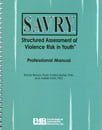
Structured Assessment of Violence Risk in Youth savry
For: Assess risk of violence in individuals ages 12-18 years
Reading Level: Adolescent
Format: Paper-and-Pencil
Length: 10-15 minutes to administer
Scoring: Hand Scored
Printed Kits
Click to browse products
Printed Forms & Handscoring Materials
Test forms, response booklets and scoring reference manuals.
SAVRY Introductory Kit
SAVRY Professional Manual
SAVRY Rating Forms (50)
Authors
Randy Borum, PsyD, Patrick Bartel, PhD, and Adelle Forth, PhD
Description
The SAVRY is composed of 24 items in three risk domains (Historical Risk Factors, Social/Contextual Risk Factors, and Individual/Clinical Factors), drawn from existing research and the professional literature on adolescent development as well as on violence and aggression in youth. Each risk item has a three-level rating structure with specific rating guidelines (Low, Moderate or High). In addition to the 24 risk factors, the SAVRY also includes six Protective Factor items that are rated as either Present or Absent.
The SAVRY is useful in the assessment of either male or female adolescents between the ages of 12 and 18 years. It may be used by professionals in a variety of disciplines who conduct assessments and/or make intervention/supervision plans concerning violence risk in youth. The SAVRY is not designed to be a formal test or scale; there are no assigned numerical values nor are there any specified cut-off scores. Based on the structured professional judgement (SPJ) model, the SAVRY helps assist in structuring an assessment so that the important factors will not be missed, thus, will be emphasised when formulating a final professional judgement about a youth’s level of risk.
Features of the SAVRY
Systematic -The primary domains of known risk and protective factors are addressed with clear operational definitions provided.
Empirically Grounded -Items are based on the best available research and guidelines for juvenile risk assessment practice.
Developmentally Informed -Risk and protective factors are based on their relationship to adolescents, not to children or adults.
Treatment-Oriented -Items have direct implications for treatment, including the consideration of dynamic factors that may be useful targets for intervention in risk reduction.
Flexible -Allows consideration of case-specific factors, along with those factors derived from research.
Practical -Time-efficiency of the instrument offers the evaluator essential information for a competent and complete assessment.
Reliability
Inter-rater reliability for the SAVRY, using trained student raters (intraclass correlation coefficient [ICC]) was .81 for the SAVRY Risk Score and .77 for the Summary Risk Rating.
Validity
In the initial validation study, the SAVRY Risk Total correlated significantly with the Youth Level of Service/Case Management Inventory (YLS/CMI) and the Hare Psychopathy Checklist: Youth Version (PCL:YV) among offenders .89 and .78, respectively. The SAVRY Protective Factors, as a whole, were negatively correlated with both of these measures.
Significant correlations have been found in other studies between the SAVRY Risk Total scores and measures of violence among young male offenders in Canada (.32 in one study and .25 in another) and among high-risk Native American youth (.56 for sample, .72 for females; Fitch, 2002).
NB: Prices are in Australian dollars inclusive of GST. NZ customers need to log in to view ex-GST prices.



